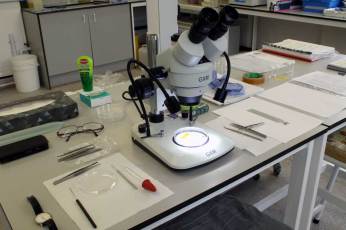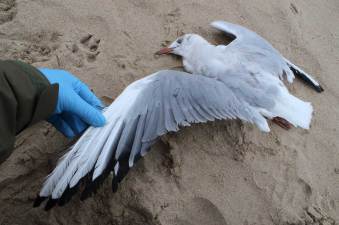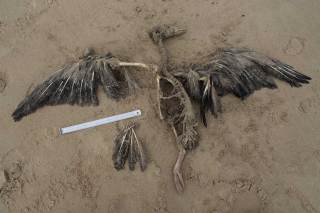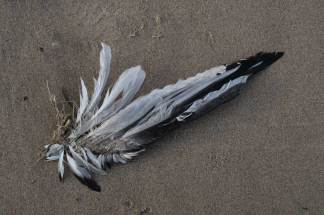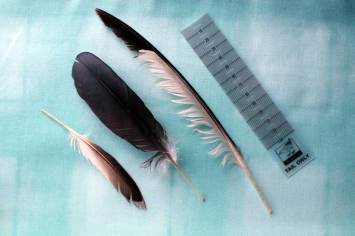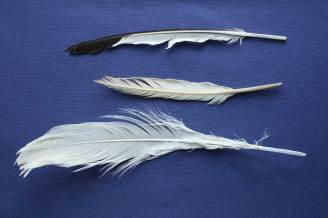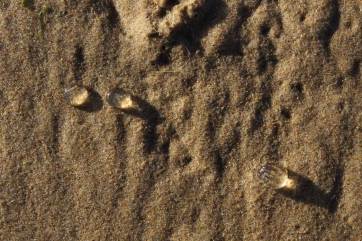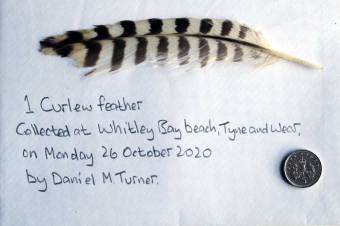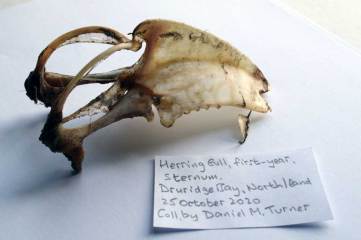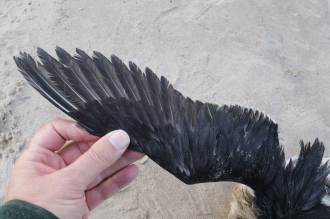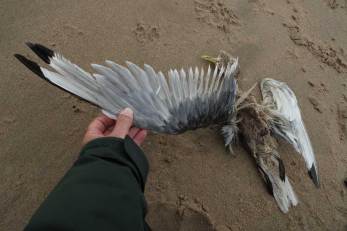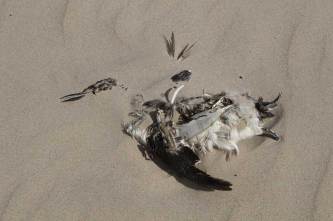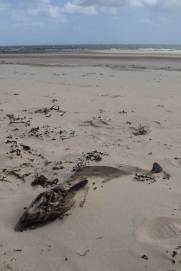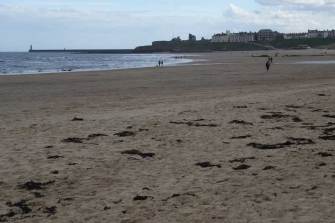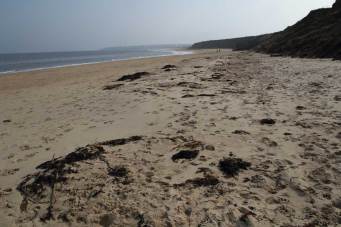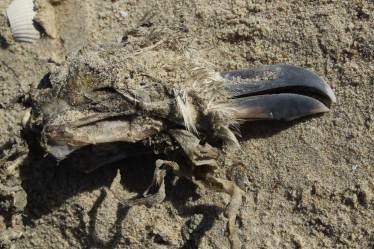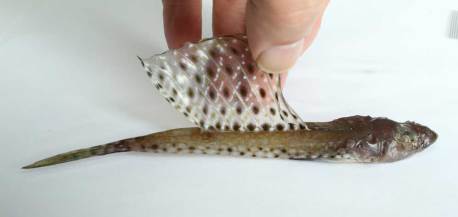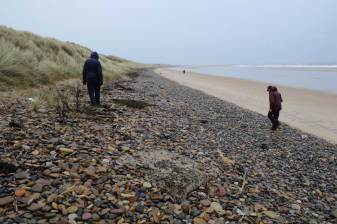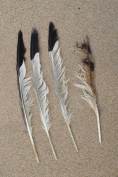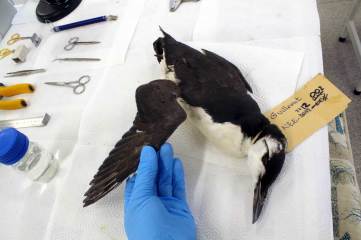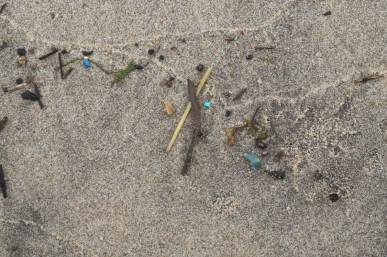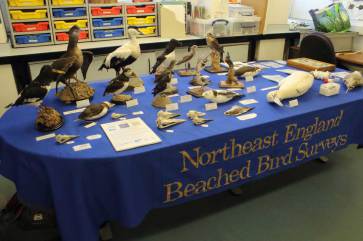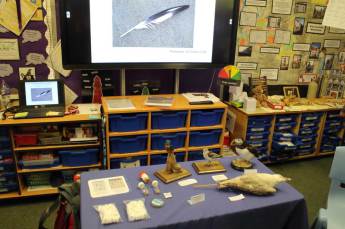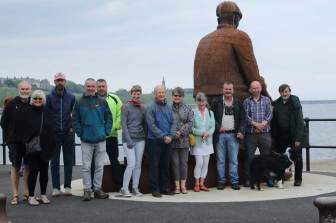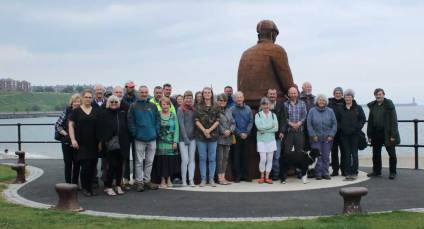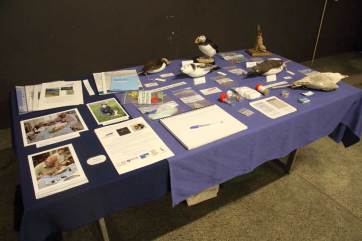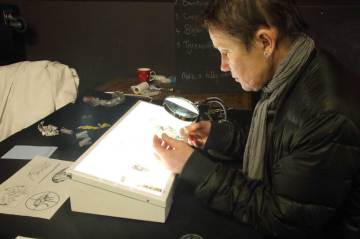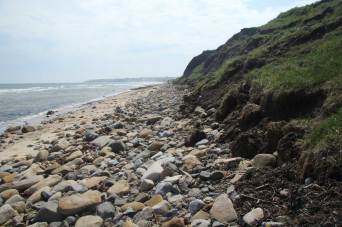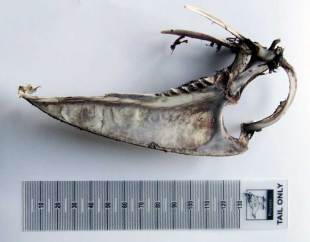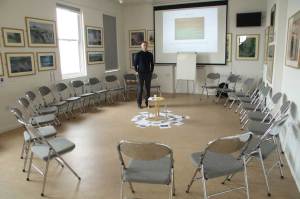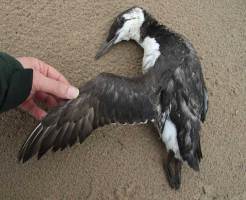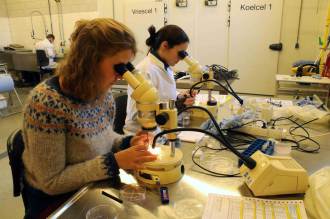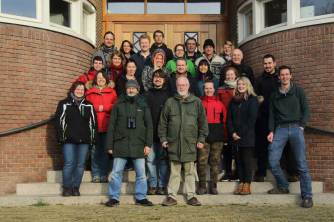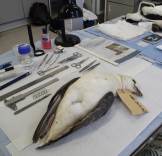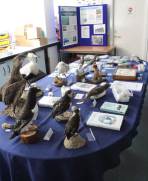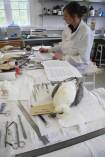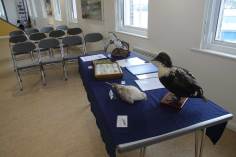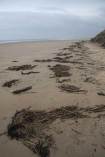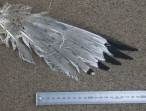Beached Bird Diary, 2017 - 2024
This diary reflects my beached bird surveys in Northeast England.
You may select any photograph to enlarge it.
12 March 2022, Saturday, North Shields, Tyne and Wear, England
I have organised and attended many days since last September at the Dove Marine Laboratory, Cullercoats. The Dove is an outstation of Newcastle Univesity in a lovely situation at a small and often busy coastal bay. Many students, researchers and staff pass through and spend time there. Our beached bird group (Northeast England Beached Bird Surveys) has had a freezer there for almost twenty years for storage of birds for analysis. We normally attend each year to work on seabirds - most often working on the northern fulmar, but over recent years we have diversified and begun to investigate some of our other specimens, notably: guillemot, razorbill, little auk and puffin. We have much more work to perform over coming years and recently we have also assisted two Newcastle University students with their projects.
28 January 2022, Friday, Tynemouth, Tyne and Wear, England
Walked on the Longsands and found a dead bird, an adult black-headed gull, which I measured and collected and have stored frozen for our studies. Its left wing was broken, when found, it was fairly fresh and the plumage clean. It did not appear so emaciated unlike some others I have found. Weight approx. 280 grams. There were several surfers in the waves and other people walking as the tide receded. Also found a few feathers and bones from a deceased feral pigeon. The temperature was 9 degrees Celsius.
14 March 2021, Sunday (second entry)
Found remains of a greylag goose (photo) at Druridge Bay, well buried with only a few feathers poking out of sand. I dug it out to examine and identify. The body had rotted, it had only one leg and the neck was vertebrae. Collected head (for a student), sternum and some feathers. Also found remains of two woodcock and a young kittiwake. Was good to savour the fresh air and wide open vista.
14 March 2021, Sunday
In the past five weeks my finds have included remains of four first-year kittiwakes on 5 km of shore (NE England) during eight beached bird surveys. Such young kittiwakes may often remain travelling before starting to nest a few years later.
31 December 2020, Druridge Bay, Northumberland
Here are three of six feathers collected on a beached bird survey with Brian Ward at Druridge Bay today. The three feathers are as follows - from lower (left) to upper (right):
- miscellaneous, right wing primary, 133 mm, possibly from a duck;
- likely shag (adult), green sheen, 171 mm, (inner primary or) outer secondary;
- kittiwake, left wing primary, 242 mm.
27 December 2020, Whitley Bay, Tyne and Wear
Here are three [moulted] feathers we collected on Whitley Bay beach today. From top to bottom they are:
- kittiwake (P10, left wing, 229 mm);
- gannet (tail, right side, second from outermost, 188 mm);
- likely (mute) swan (a secondary, right wing, 292 mm).
The survey was undertaken with Laura Robertson and Tyler Sorochka. Tyler found the swan feather.
1 December 2020, recent incidences of avian influenza within EU and UK
Please refer to the link / document below in regard of incidences of avian influenza within the EU and UK during recent days, weeks and months. As far as human health is concerned (regarding this report) there is very low risk to human health.
Since 16 October 2020, outbreaks of highly pathogenic avian influenza (HPAI) viruses have been reported in several EU/EEA countries – Belgium, Denmark, France, Germany, Ireland, the Netherlands, and Sweden as well as in the United Kingdom.
EFSA 2020 Avian influenza overview – upd[...]
Adobe Acrobat document [1.1 MB]
15 November 2020, Whitley Bay, Tyne and Wear
The beach held almost four hundred people and more than eighty pet dogs. A meadow pipit walked amongst the cliff mud and as I made my way southwards, at the tideline several sea gooseberries were observed. At the southernmost end I found the remains of an adult kittiwake wing and a headless razorbill which was disintegrating amongst the deposited seaweed. Half a shopping bag of litter was gathered to be placed in a litter bin.
26 October 2020, Whitley Bay, Tyne and Wear
My beached bird survey began at 3 p.m. on a falling tide in a temperature of eleven degrees. I recorded 168 walkers on the beach and 37 pet dogs. At the northern end were twenty turnstones and other waders. Work continued on the promenade beside the Rendezvous café and I needed to descend to the beach closer to the Brierdene Burn. I found wing remains from herring gull, kittiwake and black-headed gull. A warming portion of chips with gravy followed my beach walk.
25 October 2020, Druridge Bay, Northumberland
I recorded 139 people along the stretch of shore which I walked today as a moderate SW wind blew. An attractive wheatear on southward migration fed at the strandline and two swallows flew past, also heading south. I noted three live common gulls, ten carrion crows and two pied wagtails. There were remains of two guillemots and a first-year herring gull from which I was able to collect the exposed sternum (see photograph). The gull biometrics indicated a male bird (L. a. argenteus).
27 September 2020, Druridge Bay, Northumberland
It was cool and overcast with a light NW breeze. A Canada goose paddled in the surf as I noted bloody cranesbill, Oxford ragwort and prickly sow-thistle. A rock pipit played near the culvert and I recorded 23 examples of the compass jellyfish. There were oystercatchers, herring gulls, common gulls and cormorants. At the strandline lay a guillemot (WTips+) which had been dead for over a week (photo).
29 August 2020, Longsands, Tynemouth
The temperature was eleven degrees as a fair NNE wind blew from a cloud-filled sky. Twenty pet dogs exercised with at least 83 people on the sand as my survey began. There was a ringed plover, three sandwich terns, juvenile herring gulls and a few black-headed gulls. I found several beached compass jellyfish and a deceased adult kittiwake (photo) whose wings were in moult.
26 July 2020, Druridge Bay, Northumberland
An afternoon survey in warm, dry and sunny conditions at low tide. 277 other people walked the shore plus six surfers and four horses and riders. First find (photo) was of the remains of a guillemot (WTips-) and I collected its sternum and left wing. Another guillemot wing, from a second individual, was found later, plus wings from two comic terns (collected to identify), black-headed gull fledgling remains and tail, sternum, etc from first-summer large gull.
28 June 2020, Druridge Bay, Northumberland
Survey alone on a dry, overcast day with a hazy sun and moderate SW wind. 48 other people and 15 dogs with two horses and riders. Several sandwich terns in flight. Remains of adult black-headed gull (photo), adult kittiwake and two first-summer black-headed gulls. Other corpse finds were a black-headed gull nestling and adult lesser black-backed gull (part collected for Newcastle University student). Bill and wing measurements of latter gull corpse indicated female L. f. graellsii.
22 May 2020, Druridge Bay, Northumberland
My Druridge Bay survey had arrived after a gap of two months due to the coronavirus epidemic. Lockdown had lifted enough for me to do it. There was a swallow and a few sand martins. My first find was of the remains of a tail from a first- or second-year great black-backed gull. Then I spotted a porpoise, rotting, dead for a few weeks with the bones of its head starting to show. It was softly ripe! I measured the length, 108 cm, and captured a couple of photographs. Other finds were of wings and sternum from black-headed gull and guillemot.
30 April 2020, Tynemouth Longsands, Tyne and Wear
The wind blew lightly from the east as I walked during low tide with another 106 or more beach visitors and 32 of their dogs. Three ships were anchored at sea. There were no bird remains to record, but many live birds to observe and listen to. These included spring arrivals of sandwich terns and sand martins while eight passing kittiwakes were watched. Others included meadow pipits, linnets, jackdaws, goldfinches and three cormorants. It was good to savour the sea air and see spring flowers on the bankside. Low clouds sailed overhead.
26 March 2020, Whitley Bay beach, Tyne and Wear
Visibility was down to about half a mile as a mist clung to sea and sand when my survey began. There was no rain, the tide was low and, gently, a north-north-easterly airflow persisted. There were single, moulted flight feathers from gulls and gannets, mostly seen around the high promenade where stones gathered closely beneath. Five conjoined tail feathers were found from an unknown gull, grey and white in colour and as I walked I noted a pied wagtail, herring gull, two meadow pipits and five carrion crows for company as we all searched the shore together.
13 March 2020, Paal 17, Texel, Netherlands
I crossed down to the broad dunes with their whiskery bushes, low grass and heather to pass Ecomare as a dunnock appeared and sang well before I emerged onto the beach at Paal Seventeen. I walked the beach, southwards, for around a kilometre looking to see what I may find. It was dry and bright. Waders of the shore comprised four oystercatchers, eighteen sanderling and, I thought, four red knot. There were many cuttlebones, several of which were really large, though I collected three smaller examples to take away. In addition I found the wing remains from a black-headed gull and remnants of a first-year great black-backed gull. This latter comprised its right wing and head both of which I measured.
22 February 2020, Druridge Bay, Northumberland
I led the way during an introductory beached bird survey at Druridge Bay for Michaela and Alan; it was cold and the wind blew quite strongly. Findings were slim due to the preceding weeks of westerly winds and no bird corpses were seen. A shopping bag was filled with beach litter for disposal. Close to our northern extremity Michaela unearthed a small fish which I sealed into a bag to examine at home – it was dirty and sandy and difficult to see very well during the survey. As we progressed at the water’s edge a small number of dashing, pale-coloured sanderlings went ahead of us and a huddled flock of around 25 oystercatchers showed. The little fish (14 cm in length) was later identified as an adult male spotted dragonet Callionymus maculatus … a really nice find.
26 January 2020, Druridge Bay, Northumberland
Today brought a beach survey with Julia Black and Tom Patterson before they were to start regular surveys of their own. There were a few people walking the beach and two horses with riders passed by as three wind-surfers played in the distance. Our first main find was that of a squid, spotted by Julia. We continued and soon our next find appeared, a spiny spider crab, again found by Julia. We otherwise produced a range of single feathers from different seabird species, the empty shell from a sea potato and a broken cuttlebone.
23 January 2020, Tynemouth Longsands
A beached bird walk today uncovered three single, right wing primary feathers from adult kittiwakes and a single primary feather from the left wing of a short- or long-eared owl. The beach was very clean and the tide rising as people walked and exercised their dogs. Some more hardy souls were out in the water on surf boards while one enjoyed the surf in his short canoe.
28 November 2019, Dove Marine Laboratory, Newcastle University
This winter the Northeast England Beached Bird Surveys group is organising and carrying out analysis of some beached guillemots from recent years. We are following international protocols and especially investigating the issues of marine litter and pollution. The analysis is taking place at the Dove Marine Laboratory, Cullercoats, Tyne and Wear and is led by NEBBS group coordinator Daniel Turner.
27 November 2019, Druridge Bay, Northumberland
I carried out a two and a half hour beached bird survey along 1.5 km of the Northumberland coast. It was a foggy day. The month had been wet and reports were received of beached auks. Today’s survey unearthed remains of two guillemots, a puffin, common gull, pheasant wing and an eight-foot grey seal. A lovely snow bunting accompanied me for part of the survey. The photograph shows the upper shore in focus, with three pieces of plastic, blue and blue-green in colour, each a few millimetres in length. Such pieces are ingested by our seabirds on a regular basis. (Note and photograph by Daniel M Turner).
European Researchers’ Night, Hancock Museum, 27 Sept 2019, 6-10 pm
There was a beached bird (NEBBS) group table in the Natural Northumbria gallery at the Seas and Coasts hide in the Hancock Museum (Newcastle-upon-Tyne). The NEBBS group coordinator gave two 12 minute talks in the museum at 7:45 and 8:45 pm. Many visitors attended the stalls, explored the museum and talked with researchers.
22 September 2019, Dove Marine Laboratory
From 12:30 to 3:30 pm the Dove Marine Laboratory (Cullercoats) was open to the public as part of a Heritage Open Day on Tyneside. Our beached bird group had a stall with several specimens on display and group coordinator, Dan Turner, was present to talk with visitors. It was a busy three hours which actually extended for longer as the last visitor remained to talk beyond closing time. Dan answered many questions and talked in some detail about the research. Some questions remained to investigate for a later response.
12 June 2019, Southridge First School
Had received an invitation to speak to Years 3 and 4 at Southridge First School, Whitley Bay. There were two groups of children, about sixty pupils or two classes in each, with whom to discuss our beached bird projects, an hour on each occasion. The children were keen and produced a barrage of questions. It was a great experience. The school was having a STEM (science, technology, engineering and mathematics) week and the talks fitted with this theme.
19 May 2019, NEBBS Group Meeting
The Northeast England Beached Bird Surveys group held their 2019 meeting at the Old Low Light, North Shields fish quay. There was a good attendance with a dozen surveyors and another seventeen attenders who were either speakers or involved / interested parties. We listened and watched presentations from the St Mary’s Island Seal Watch volunteers, Mick Smith (a retired fisherman), the NEBBS Group coordinator, photographer Chris Heal and Greenpeace. It was a full and busy programme, but we had time for hot drinks and scones too! Please see our meeting photos below … a dozen surveyors and almost the complete meeting attendance.
12 January 2019, Daedalus Film and Science Festival
The Northeast England Beached Bird Surveys group was invited to have a display table today at the Star and Shadow Cinema, Warwick Street, Newcastle. What a great venue! Also a lovely bunch of volunteers! Our table was open to visitors from 2 pm to 5 pm and many came to see, listen and talk. Our presentation in the cinema, mid-afternoon, lasted around half an hour for young and older alike. Some interesting questions followed. Also during the day, artist Julia Barton, from NW Scotland, held workshops in relation to her littoral art project while there was a showing of the Australian documentary ‘Blue’ in the evening.
26 May 2018, Whitley Bay
A dry day with temperature 12-14 C and rising tide while my beach survey was performed between 11 am and 2 pm. The shore was quite clean with a fairly light deposit of dead seaweed and presence of many flies. Live birds included a pied wagtail, carrion crow, three passing fulmars, herring gulls and northerly movement of sandwich terns. My beached bird finds, on southern section, comprised: guillemot skull with upper mandible and remains of a second guillemot (first-year in age) from which the exposed sternum was collected.
28 April 2018, Philosophical Enquiry
The photograph shows Michael Atkinson on the top floor at the Old Low Light, North Shields fish quay. He had readied the room for a Philosophical Enquiry involving meditation and mindfulness. The stimulus for the event was plastic in the oceans, so I had brought artefacts and gave a short presentation to help get things underway. It was a very interesting experience with a good group of people to talk about their ideas and consider what could be done to help resolve the problem.
10 March 2018, Druridge Bay, Northumberland
On a stretch of 1.5 km there were 14 recently beached guillemot corpses, three puffins, two razorbills and a pair of herring gull wings. I collected a complete adult guillemot and first-year puffin along with some bird bones. The poor weather (snow, easterly winds, rough sea and cold conditions) of the past fortnight has been taking a toll on our seabirds. All today’s auks were emaciated.
22-23 February 2018, Netherlands
Remaining for extra days after the Fulmar Workshop, I received tuition from Susanne Kühn concerning fulmar stomach contents analysis. Susanne instructed on stomach flushing as well as sorting, cleaning, weighing and identification of the contents. She is working towards a PhD and carrying out research with Dr Jan Andries van Franeker at Wageningen Marine Research.
16-21 February 2018, Netherlands, Fulmar Workshop
Attending this international workshop was most interesting. Attendees came from: Iceland (1), Norway (1), Germany (5), Holland (5), Belgium (4), Spain (2), Scotland (5) and England (2). The photograph shows our group at its maximum attendance by 25 people on Sunday, 18 February outside Wageningen Marine Research, Den Helder. We performed laboratory analysis on northern fulmars and Cory’s shearwaters, attended a discussion day and enjoyed some birding on the wonderful island of Texel. This workshop, the fourteenth since the first in 2002, was organised, as always, by Dr Jan A van Franeker.
16 December 2017, Druridge Bay
For my monthly Druridge Bay beached bird survey I was joined by Laura from Coast Care. We found the wing remains from an adult black-headed gull at the high tide strand line. The outermost primary feather of each wing was still in growth. One leg accompanied the find, which was likely a fox kill. The weather was bright, but cold with ice nearby. We also collected single moulted feathers from gannet, great black-backed gull, herring gull, kittiwake and curlew. The shore was relatively clean as we walked and the tide approached. A pair of bright and active stonechats accompanied us a while.
18 October 2017, Dove Marine Laboratory (Wednesday)
Two northern fulmars were processed at the Dove Marine Laboratory today with a range of tissue samples collected for the future. The bird shown here was an immature female. For part of the day we were joined by a film crew from the BBC ‘Inside Out’ series who came to record our findings and learn more. The work proceeded nicely. To help during the analysis we had Russell Davis on hand and two Newcastle University Masters students.
9 August 2017, Dove Marine Laboratory (Wednesday)
It was the Dove Marine Lab heritage open day and the beached bird group had been invited to have a table. I dropped things off on Tuesday afternoon and started to set up our display. Included were three of the specimens newly prepared by taxidermist Adrian Johnstone with a grant from the Northumberland and Tyneside Bird Club. Table set up concluded in the early morning before visitors started to arrive and tour the building. It was a great day with lots of visitors, of all ages, asking questions about the different bird projects. A wonderful, newly designed (by Gemma McGregor) and printed, colour poster was ready to include at our stand.
16-18 May 2017, Dove Marine Laboratory
Three days in the Dove Marine Laboratory (Newcastle University) allowed initial processing of eight fulmars found dead in northeast England and eastern Scotland. Assistance came from members of our beached bird group surveyors. The seabird stomachs were removed for contents analysis, to be carried out in the Netherlands by researchers from Wageningen Marine Research as part of the ‘Save the North Sea’ fulmar project.
15 April 2017, Old Low Light, North Shields fish quay
With an attentive audience seated, my presentation progressed on the theme of the beached bird and fulmar projects in northeast England and beyond. Outside the weather was bright and sunny, but a little on the chilly side. Those attending came up with a variety of questions which I attempted to answer. We concluded with a short presentation about some of the birds of the river mouth. There were newsletters for browsing and an information sheet to take away. One of the birds on display was a very smart immature drake eider which was staying with me for a few short days.
March 2017, Druridge Bay
It was a grey day with a drizzly morning as I started my Druridge Bay beached bird survey on 29 March. Three guillemots were found – an adult and two first-year birds. Other finds comprised black-headed gull and kittiwake, but neither was quite complete and both had been dead for several weeks. There were also three or four rabbit carcasses.
22 – 23 February 2017, Bird Display
I organised a bird and shore display at the Old Low Light (North Shields fish quay) on Wednesday - Thursday, 22 - 23 Feb 2017. This was in the heritage gallery where I talked with visitors. We discussed such subjects as birds of the shore, Tyne birds, nesting gulls, fulmars in the North Sea and beached birds. Visitors were shocked and surprised by the extent of the effects of marine litter and pleased to hear about our study and its aims to improve the marine environment.
February 2017, North Tyneside
There were two first-year puffins on Tynemouth Longsands to be collected on Sunday 19th. Prof Mike Harris reported to me that the only other UK beached puffins of which he was aware this winter were three from Orkney i.e. two first-year and one second-year bird. On both Tynemouth Longsands (19th) and Whitley Bay beach (20th) very many white cuttlebones were to be seen at the uppermost strandlines. I do not recall seeing as many cuttlebones here in the past 14 years.
January 2017, beach surveys
I found no bird remains to speak of. During my Druridge Bay survey I watched a bright pair of stonechat and spotted the body of a rabbit. Whitley Bay beach produced some icicles at the base of the cliffs as I recorded six lively rock pipits and two meadow pipits feeding amongst the shore detritus with turnstones and sanderlings too.


